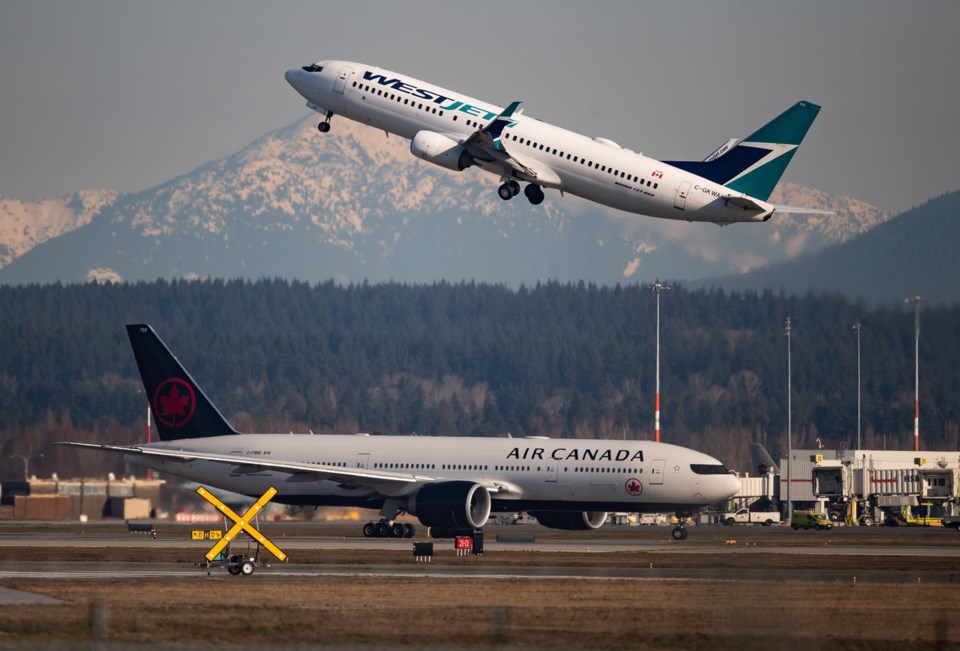Canada should allow 100 per cent foreign ownership of domestic-only airlines, the Competition Bureau says in a new report highlighting the country's "highly concentrated" aviation industry.
In a market study released Thursday, the watchdog suggested creating a new class of airline that operates only in Canada but could have owners from outside its borders, opening the gate to global expertise — and cash.
The current foreign ownership cap sits 49 per cent. In addition, no more than 25 per cent of a carrier can be owned by any one foreign entity, a proportion the Competition Bureau proposed raising to nearly half.
"Allowing more foreign investment in Canadian airlines improves access to capital, drives growth and promotes competition," the report said.
Low competition in the airline industry remains a big hurdle to lower prices and better service across the country, and remote communities especially, the report found.
“Competition in Canada’s airline sector has struggled to take off,” it said, noting consumers’ dissatisfaction with fares, flight options and service quality.
Air Canada and WestJet together account for between half and three-quarters of all domestic passengers at major airports, according to the study.
Though competition improved between 2019 and 2023 with the arrival of Flair Airlines and the expansion of Porter Airlines, market concentration remains “extremely high” and competition from new entrants fragile, the bureau said, with the field dominated by a few large airlines.
“Many Canadians report that international flights are often cheaper than flights within Canada,” it noted.
The report recommended a basket of reforms that include shifting the financial burden of airport maintenance away from passengers, thus lowering ticket prices and allowing more consumers to book flights on budget carriers, as well as expanding market access for new entrants by allowing secondary airports to compete with major hubs.
Currently, flight exclusivity clauses often mean only one airport in a local area can host international flights.
“New entrants to the market face aggressive competitive responses,” the study found.
The report also called for an end to the transport minister's power to override mergers and acquisitions deemed anticompetitive under a federal review process. It also urged industry-wide publication of data on delays and cancellations to help consumers make informed choices, on par with the United States and United Kingdom.
It further stressed the unique challenges faced by remote communities and recommended a working group to ramp up service to the North, where air transportation is an “essential lifeline, even for residents who never fly” but whose food and medicine arrive by plane.
“New entrants face major barriers because existing carriers control critical assets at the major northern airports,” the report said. It asked the government to "tailor regulations to the northern context" and weed out unnecessary costs.
Over the past 20 months, four low-cost carriers have disappeared from the skies, as Lynx Air and Canada Jetlines shut down and WestJet folded subsidiary Swoop and the recently acquired Sunwing Airlines into its main-line service.
While the country's biggest cities remain amply served, smaller ones have fewer options, which can also result in higher prices and, when things go awry, stranded passengers.
The Calgary-Saskatoon route saw flights fall 39 per cent to 412 last month from 673 in May 2019, now that the airspace between Alberta and Saskatchewan’s two biggest cities is served with non-stop flights by WestJet only — Air Canada pulled out over two years ago — according to aviation data firm Cirium.
Flight volumes between Ottawa and Fredericton decreased 23 per cent in the same period to 89 trips after Air Canada exited the route, leaving Porter as its sole carrier.
Routes served by just one airline tend to be more expensive, the report noted.
“Our research shows that when just one new competitor flies on a route between two cities, airfares go down by nine per cent on average,” the report said.
This report by The Canadian Press was first published June 19, 2025.
Companies in this story: (TSX: AC)
Christopher Reynolds, The Canadian Press



